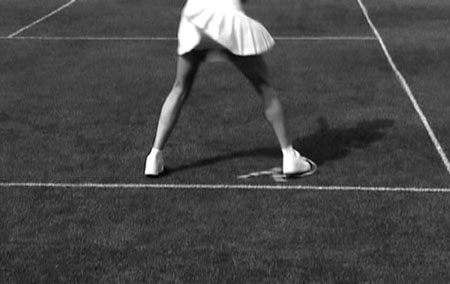View current page
...more recent posts

Diana Kingsley, Court Disaster, 2000-04, still from 2.5 min. loop, DVD on video monitor
New York artist Diana Kingsley, who I've I've written about a few times, just concluded a show at Leo Castelli, after earlier appearances at Derek Eller and Bellwether. The New Yorker reviewed it during its July/August run, and this week, Artnet observes: "With its visual reductiveness, Kingsley's work has the starkness of pulp fiction, where bare facts and descriptions set a mood more than they add up to a story. Her video narratives are tenuous, threatening to wink out and leave us with still imagery." To which I would add that the videos, like her still imagery, seem calm and innocuous at first but each contains some hint of the ominous, a mini-disaster waiting to happen.
More of the conversation Chris Ashley and I are having on painting and technology, from comments to an earlier post:
Chris: You say, "As for painting, I have no plans to do it--I'm more interested in the problem-solving of how to make interesting, resonant, stand-alone objects with the computer, printers, photocopiers, etc., and intertwining that practice with purely online things like animated GIFs." So, you're not exactly saying that you'll never paint. And I'm not trying to make you. I guess I'm wondering if you're leaving the option open so that if, at some point, a situation presents itself that tells you that the meaning you're working on requires the use of paint, whether, say, as enhancement or contrast, or for expression or irony, would you recognize that and not just follow a rule that says no paint, but instead follow the work and use paint?
And when I read your thoughts, "By 'real world grit' I was referring to the legal pad, office paper, product boxes and such that I've incorporated into the work," you're referring to materials that have in themselves a whole load of received meaning, and that could have, for some viewers, a kind of grit, or romance, or revulsion. You know, is it possible that at some point the viewer says, "Oh, the use of office materials in art is dead," as has been said about painting, as will be said about installations, and large photos mounted on aluminum panels, and the creation of characters for video or performance, and whatever else you're going to find in all of the galleries everywhere this "season."
I'm just trying to make the obvious point that probably no one is arguing against anyway that paint, in the many ways it's possible to use it, is, and will continue to be, a viable technology, whereas someday my HTML drawings will no longer be viewed in their native environment. The technology will fade. And I'll have no control over that. In 25 years using MacPaint will probably be pretty hard, but you'll always be able to buy a ten-color watercolor set at a stationary or educational supply store.
Tom:"Oh, the use of office materials in art is dead,"
My use of those materials died around 2000, with my permatemp gig. (Which is not say I might not use them again if I got a similar gig, but right now I'm working with "home consumer technology.") The criterion shouldn't be hipness so much as relevance: there's a history of artists working with the newest technologies (e.g., ground pigment) with a concomitant falling off of interest in older technologies (smearing roots on the cave wall). I'm more interested in applying what I would call a "painterly" approach to tech than painting itself (the physical side of which I never liked that much anyway). I would say HTML drawings have as good a chance of surviving (via being saved on hard drives, etc.) as physical art objects (many of which end up in landfills and moldering in relatives' basements). And as for media surviving, who cares what happens to art in 25 years?
